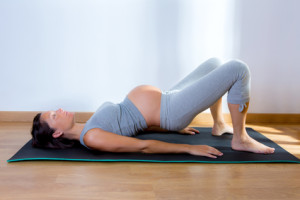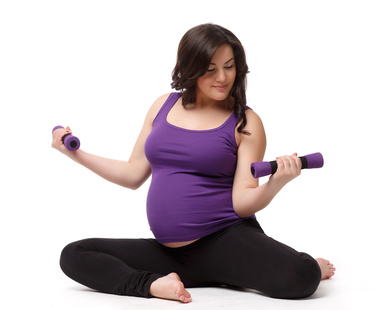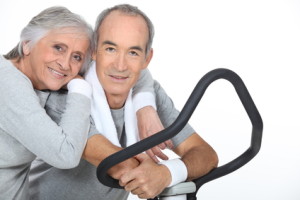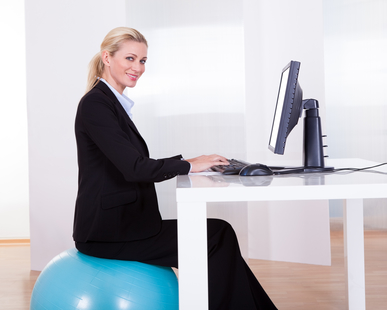Exercise & Pregnancy
 The understandable fear (due to things like decreased oxygen supply to the baby) that existed with pregnancy & exercise years ago is no longer warranted. Because of substantial research, it is now safe for women to continue or start exercising while pregnant. As long as she gets approval from her doctor & seeks out a qualified and certified fitness professional, she should be confident in knowing that the recommendations below will help her.
The understandable fear (due to things like decreased oxygen supply to the baby) that existed with pregnancy & exercise years ago is no longer warranted. Because of substantial research, it is now safe for women to continue or start exercising while pregnant. As long as she gets approval from her doctor & seeks out a qualified and certified fitness professional, she should be confident in knowing that the recommendations below will help her.
Considerations & Exercise Suggestions
1. Posture Change from the Growth of the Baby: As a result of the baby growing in the wound, the mother to be’s posture will change. This causes certain muscles to become weak, particularly her core. In the 1st and 2nd trimester, a mother to be should focus on strengthening her core through exercises such as planks, bridges, and birddogs. Once the 3rd trimester hits, it would be wise for the mother to be to avoid supine or prone core exercises. She can still work her core by doing standing exercises such as medicine ball chops, reverse chops & rotations. All of these exercises can be performed 2-3 days/week, 1-2 sets of 12-15 reps with appropriate rest time (45-90 seconds) between sets.
2. Cardiovascular Exercise: With the growth of the fetus, also comes more stress to the mother to be’s heart and lungs. As a result, her ability to work harder and longer is decreased. However, a mother to be can still perform low impact or step aerobics that do not involve jarring motions. Walking on the treadmill, stationary cycling and water aerobics done 3-5 days/week for 15-30 minutes is suggested.
3. Flexibility Exercise: Because the mother to be’s body posture has changed, this may cause certain muscles to overwork or become tight. As a result, she may feel the need to stretch certain muscles. This is ok to do so. Static and active stretches are advised along with foam rolling that can be tolerated. However, foam rolling on varicose veins or swollen muscles should not be done. I would advise stretching muscles that appear to be overworking such as her calves and lower back. This can be done everyday for 1-2 sets, holding each stretch for 30-60 seconds.
 4. Weight Training Exercise: Circuiting training has shown to be very effective for mother’s to be throughout their entire pregnancy. These include exercises that work the entire body and can be performed back to back with little rest in between. I recommend exercises that work the following muscles: legs, chest, back, shoulders and arms. They can be done 2-3 days/week, 1-2 sets of 12-15 reps. The rest period can be in between 45-75 seconds.
4. Weight Training Exercise: Circuiting training has shown to be very effective for mother’s to be throughout their entire pregnancy. These include exercises that work the entire body and can be performed back to back with little rest in between. I recommend exercises that work the following muscles: legs, chest, back, shoulders and arms. They can be done 2-3 days/week, 1-2 sets of 12-15 reps. The rest period can be in between 45-75 seconds.
5. Cautions: Mothers to be should stop or avoid exercises that cause nausea, dizziness, stomach pain, prolonged shortness of breath, bleeding and fainting.
Conclusion
By taking the appropriate precautions, mothers to be can safely exercise during pregnancy. As a result, the pregnancy can be smoother and the recovery can be quicker.
Helpful links for exercises
http://blog.nasm.org/fitness/exercise-pregnancy-physiological-changes-exercise-programming/
http://www.fitpregnancy.com/exercise/prenatal-workouts/weight-training-pregnancy
Maurice D. Williams is a personal trainer and owner of Move Well Fitness in Bethesda, MD.
Source
Clark, Sutton, Lucett. NASM Essentials of Personal Fitness Training, 4th Ed. Revised. 2014



 They are two major forms of arthritis:
They are two major forms of arthritis:  Flexibility: Static stretching and foam rolling may be used as tolerated for the areas of the body that appear to be overactive. These can be performed seated or standing.
Flexibility: Static stretching and foam rolling may be used as tolerated for the areas of the body that appear to be overactive. These can be performed seated or standing.
